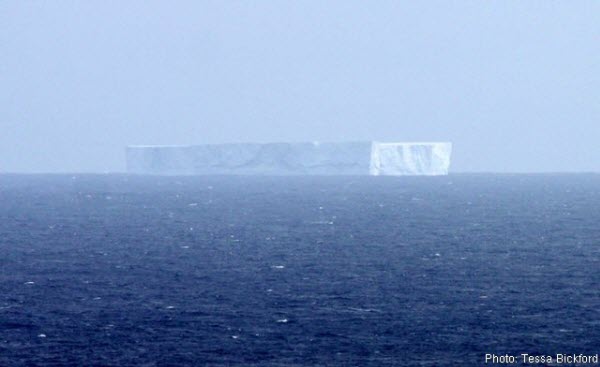Amazing though it might seem to those roasted in the recent South Australian and NSW heat waves, yet another flotilla of icebergs is making good speed toward the south-eastern tip of New Zealand’s South Island.
At least 130 icebergs, some more than several kilometres long, may be visible from the hills or even the beaches on the Otago coastline near Dunedin by the end of the week, according to NZ government oceanographer Dr Mike Williams.
 Tabular iceberg passes Macquarie Island
Tabular iceberg passes Macquarie Island
The bergs, remnants of a several huge tabular or flat-topped bergs that broke off the Antarctic ice shelves between 2000 and 2002, have already passed Macquarie Island, where some came close to its shores earlier this month.
They are being tracked by Australia’s Antarctic Climate and Ecosystems CRC in Hobart, which has posted detailed maps of the berg cluster down to less than 200 metres across above the water, or to the limit of satellite resolution.
However, as the bergs further disintegrate, they spawn multitudes of satellite-invisible bergs, some more than 10 metres across, which are very hazardous to shipping and have led to maritime iceberg warnings for the parts of the Southern Ocean where they are rarely seen.
This time the icebergs are expected by NZ authorities to exceed the spectacle caused in 2006 when the first mainland sightings since 1931 were recorded from high hills near Dunedin.
The November 2006 bergs lined the horizon and resolved into an armada of icy towers through binoculars or in close-up to those on chartered sightseeing flights.
Auckland University polar scientist Dr Paul Augustinus says the berg outbreaks are unlikely to be related to global warming.
“I wouldn’t like to speculate on the cause,” he says “it could relate to a number of factors such as the break-up of a larger iceberg.”
And meteorologists say the bergs have been helped in their long voyage north by very cold weather and strong winds affecting the Southern Ocean from Macquarie Island to New Zealand in recent weeks.
Dr Neal Young, a glaciologist with the Australian Antarctic Division, said more than 100 icebergs had been detected in just one cluster in satellite images, but because of extensive cloud cover in the area the real number was uncertain.
“All of these have come from a larger one that was probably close to 20 square kilometres in size when it left Antarctica,” he says.
The Australian Antarctic Division has posted a lay person’s guide to the truth about ice losses and gains in Antarctica, which identifies small net contributions to sea level in recent times.
It’s a document likely to disappoint climate-change deniers and proponents alike, in that it doesn’t support any of the headline-grabbing claims made either side of the populist debate.









Amazing stuff. Does it really take 6-9 years for an iceberg to make it here from Antarctica?
Apparently it can. If the source is huge, some of them have been comparable to Tasmania in breadth if not length, they tend to drift around the fringes of the Antarctica and even running into other other ice shelves or hitting the coastline for a while. They as the crack up, the chunks start to drift north as well as around the far southern ocean until eventually they get into the zone, and down to the size, where rapid melting occurs. Normal ice bergs that just break off in small chunks from an ice shelf never last as long as those that have been found to have been up around 80 kilometres in length or longer.
In 1979, on assignment for the Sydney Morning Herald, I went to a dive hole drilled through the Ross Ice Shelf at McMurdo. The underside of the ice the divers were exploring was floating over water super chilled to -8C. There were sub polar corals and other marine life forms down there. But the ice itself is also depressed below zero, and at that stage so cold that for a while as its gets pushed further from shore by the parent glacier it gains mass from the sea freezing onto it.
Suggestion for finetuning the new Crikey format. If an article states that “the berg outbreaks are unlikely to be related to global warming” and if an expert feels himself unqualified to “to speculate on the cause” of the bergs, then perhaps the article shouldn’t be tagged with the ‘Climate Change’ Comment Counter…